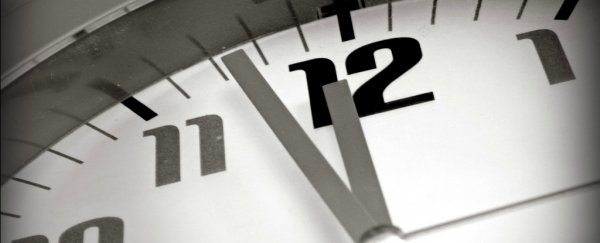Believe it or not, the Doomsday Clock is very real, and right now it's very close to midnight – just 3 minutes away to be exact. "Three minutes is too close. Far too close," the members of the Science and Security Board for The Bulletin of the Atomic Scientists announced on Tuesday in a statement.
What happens at midnight? Global catastrophe. The Bulletin of the Atomic Scientists first debuted the Doomsday Clock in 1947 as a symbolic way to track how close humanity was to annihilating itself – mainly through nuclear war, due to the advent of nuclear weapons.
Today, nuclear war is just one of many risks the board weighs each year when it sets the clock's time.
The Bulletin of the Atomic Scientists is an academic journal that features the latest research on topics like nuclear weapons of mass destruction, emerging technologies, climate change, and disease.
Anything that addresses the potential for global destruction – in one form or another – is high on The Bulletin's list.
The Doomsday Clock is a symbolic way that the board members can combine all potential risks from the past year into a single, understandable form. Here's how humanity has measured up over the last 69 years:
 FastFission/Wikimedia
FastFission/Wikimedia
In 2015, board members made a bleak move by setting the minute hand on the clock from 5 minutes down to 3 minutes to midnight. It was the first time we'd been that close since 1987.
On Tuesday, the board said that they will keep the clock's time at three minutes to midnight for 2016.
"That decision is not good news, but an expression of dismay that world leaders continue to fail to focus their efforts and the world's attention on reducing the extreme danger posed by nuclear weapons and climate change," the board wrote in a statement.
It added: "The Iran nuclear agreement and the Paris climate accord are major diplomatic achievements but they constitute only small bright spots in a darker world situation full of potential for catastrophe."
Some of the reasons the board cited for its decision include:
- The United State's decision to spend $350 billion over the next decades to maintain and modernise its nuclear forces and infrastructure.
- The conflict happening over free passage in the South China Sea.
- The fact that China, Pakistan, India, and North Korea are all increasing their nuclear arsenals.
- And that 2015 was the hottest year on record.
In a press release The Bulletin published on January 22 they give a dire warning to humanity:
Because the diplomatic successes on Iran and in Paris have been offset, at least, by negative events in the nuclear and climate arenas, the members of The Bulletin of the Atomic Scientists Science and Security Board find the world situation to be highly threatening to humanity – so threatening that the hands of the Doomsday Clock must remain at three minutes to midnight, the closest they have been to catastrophe since the early days of above-ground hydrogen bomb testing.
This article was originally published by Business Insider.
More from Business Insider:
